The IBM FlashSystem 5300 is IBM’s answer to high-performance, cost-effective storage for the entry-level enterprise market. This 1U storage array features IBM’s FlashCore Modules, offering up to 1.8PB of effective storage capacity. The 5300 also packs features like AI-powered data management to provide high-speed storage with built-in data protection and reduction capabilities.
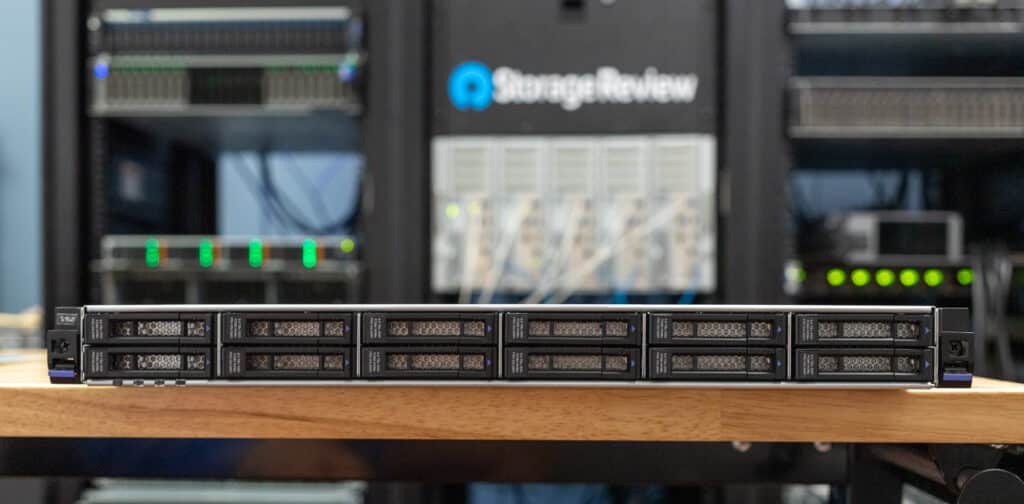
The IBM FlashSystem 5300 provides a top-line performance throughput of up to 28.6GB/s. Compared to the FlashSystem 5200, the 5300 achieves a 1.45x increase in real-world IOPS, from 270,000 to 400,000, and a 1.3x improvement in bandwidth, rising from 21GB/s to 28GB/s. These figures are based on a 16k block size, 70% reads, 30% writes, and a 50% cache hit workload.
FlashCore Modules: Key to IBM’s Storage Density and Performance
By integrating advanced data reduction technologies like inline compression and deduplication directly into the FlashCore Modules, the drives allow significantly more data to be stored in less physical space, optimizing the storage footprint. These proprietary NVMe-based “SSDs” are engineered to maximize density and efficiency without sacrificing performance. They are essential to the IBM FlashSystem 5300’s ability to deliver up to 1.8PB storage capacity in a 1U form factor.
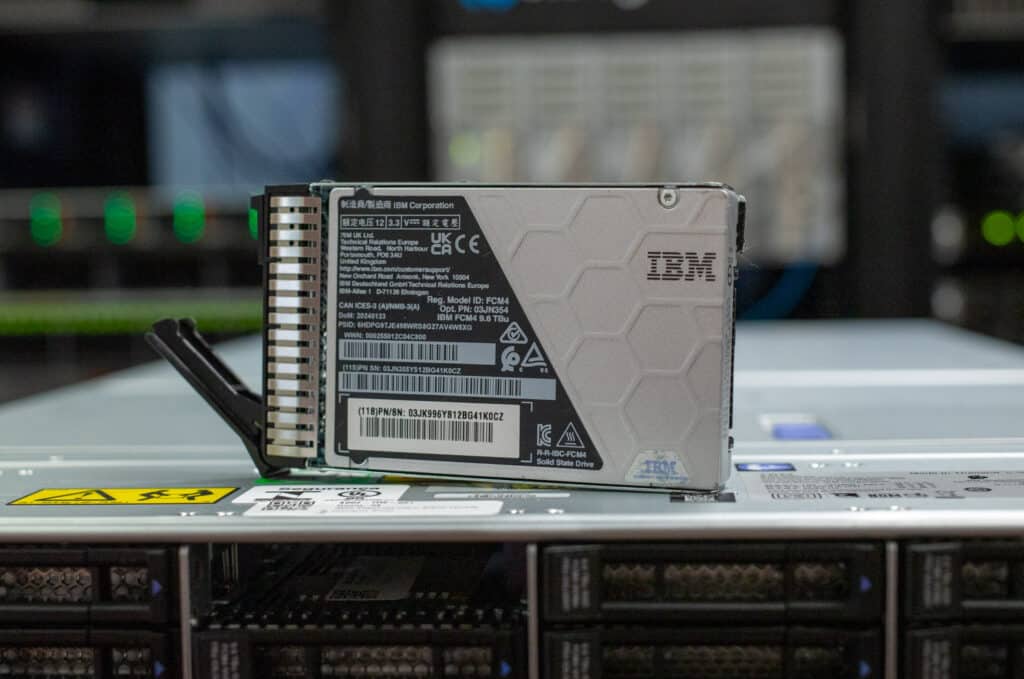
Critically, the data reduction at the drive level means the CPU is free for other tasks. Inside each module is an AMD Xilinx SoC that handles the heavy lifting. Despite substantial investment, these drives belong to the computational storage category, which has not achieved broad success in the IT industry. That said, IBM Storage has sorted out the benefits, letting the FlashSsytem 5300 offer such robust capacity in 1U. In addition to compression, the FlashCore Modules handle encryption, ransomware threat detection, entropy management, and compression deltas.
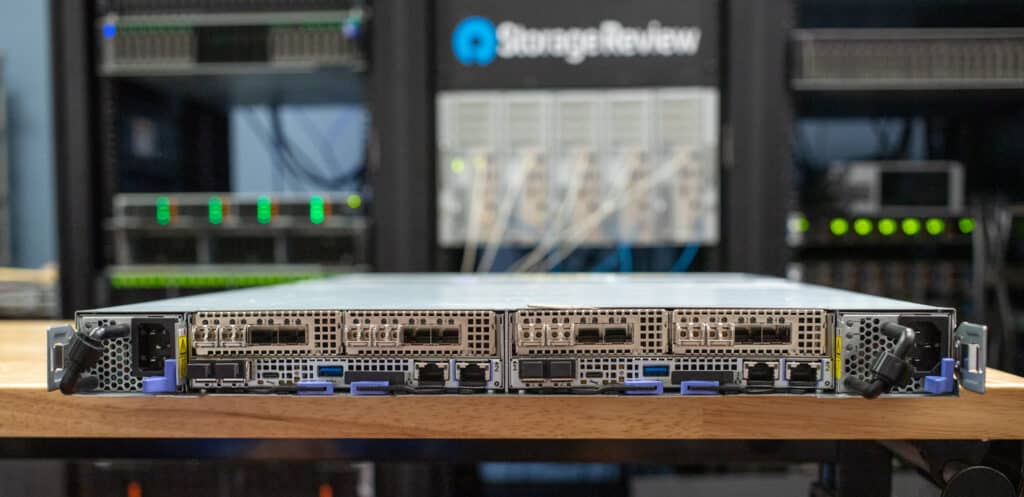
IBM’s ongoing quest to offer future-proof solutions is evident in the 5300, a storage system designed to counter the threat of quantum computers breaking current encryption methods. The 5300 employs asymmetric cryptographic algorithms, including CRYSTALS-Dilithium for authentication and firmware verification and CRYSTALS-Kyber for secure key transport of unlock PINs from controllers to Flash Core Modules (FCMs).
Additionally, the system ensures data-at-rest security by utilizing XTS-AES-256 encryption for customer data stored in flash memory. As IBM continues to innovate with the FlashSystems, it represents an important step in providing long-term data protection and security assurance for organizations in an evolving technological landscape.
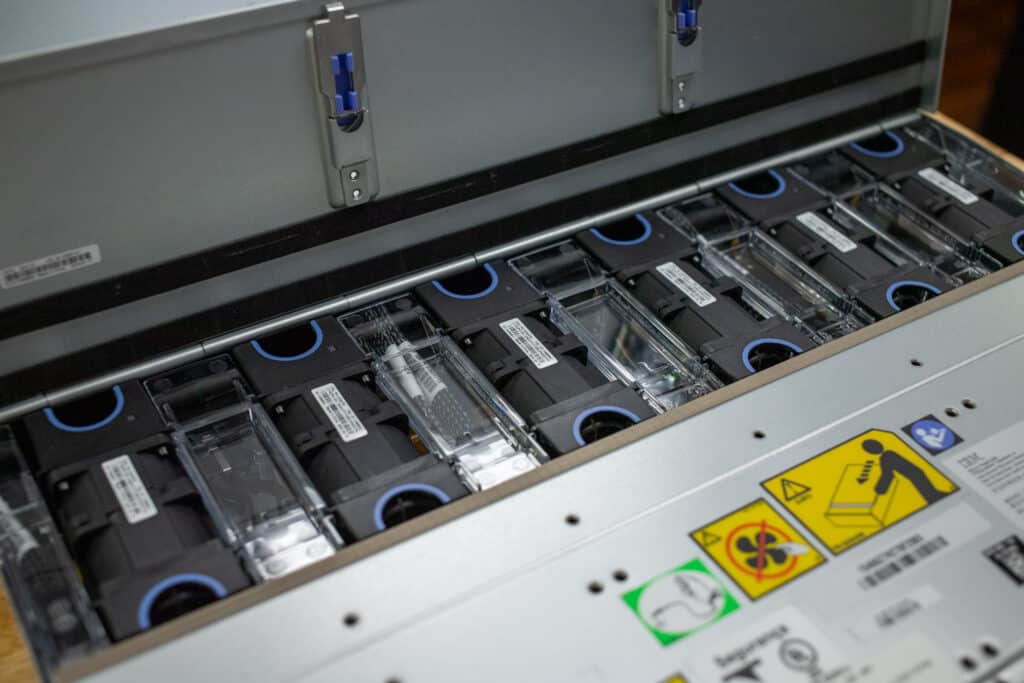
IBM Storage FlashSystem 5300 Specifications
The 5300 has dual controllers, or as IBM calls them, “Node Canisters,” in active-active configuration. These can be configured with various options to help data move across the network. The array has four onboard 25/10GbE Ethernet ports, supporting SFP28, SFP+, and RJ45 interfaces, allowing for high-speed data transfer and network flexibility. Additionally, the 5300 can be configured with up to 16 Fibre Channel host ports, supporting either 32Gb or 64Gb FC, providing robust connectivity for high-performance workloads.
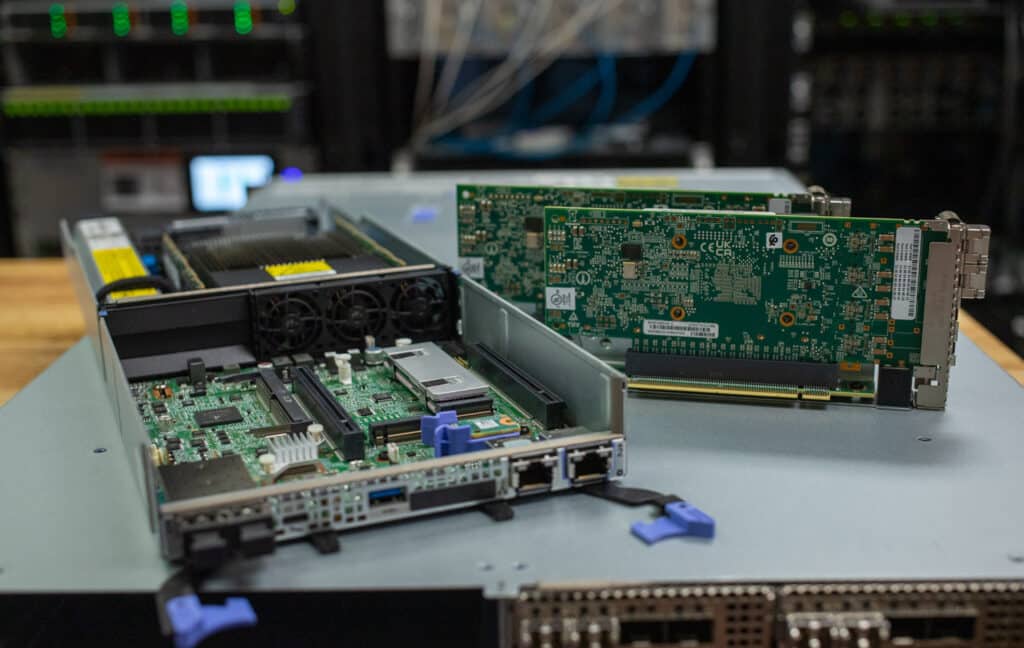
| Form Factor | 1U height, AC power |
| Storage Enclosure | NVMe control enclosure with up to 12x NVMe FlashCore Module 4 (FCM4), SSD, or SCM |
| FlashCore Module Capacities Supported | 4.8, 9.6, 19.2, and 38.4TB |
| Data Reduction | Inline compression with FlashCore Modules (FCM) |
| Processor | 12-core Intel Ice Lake CPUs with QuickAssist Technology (QAT) |
| Cache | Up to 512GB |
| Network Ports | 4x 25/10GbE flexible onboard ports with optional configurations: SFP28, SFP+, RJ45 |
| Maximum Host Ports | 16x 32Gb FC / 10GbE or 8x 64Gb FC |
| Volumes | Supports up to 8,192 volumes |
| Snapshots | Up to 15,863 snapshots |
| Snapshot Capacity | 10 PiB |
| Security Features | Inline threat detection with real-time data monitoring (RTD), Encryption, and Secure Boot |
| Advanced Snapshot Management | Volume Group Snapshots, Safeguarded Copy, Internal Scheduler |
| Availability Features | HyperSwap, Predictive Block Allocation (PBHA) |
| Data Protection | PBR (Protected Block Recovery) |
| Cloud Integration | Storage Insights Integration |
| Virtualization Support | Embedded VASA Provider, VMware vVols replication |
| Connectivity | NVMe over Fibre Channel (FC) or TCP |
| Other Technologies | Transparent Cloud Tiering (TCT) |
Interface and Management
The IBM FlashSystem 5300 integrates AI-powered management through IBM Storage Insights, a cloud-based tool that provides advanced monitoring, analytics, and predictive maintenance to optimize storage operations. By leveraging AI, Storage Insights helps businesses monitor performance, detect potential issues early, and predict future capacity needs based on historical usage trends. This reduces manual intervention and ensures that systems remain healthy and secure. Additionally, the FlashSystem 5300’s user-friendly GUI simplifies day-to-day management tasks, allowing administrators to easily configure and monitor the system without requiring extensive storage expertise.
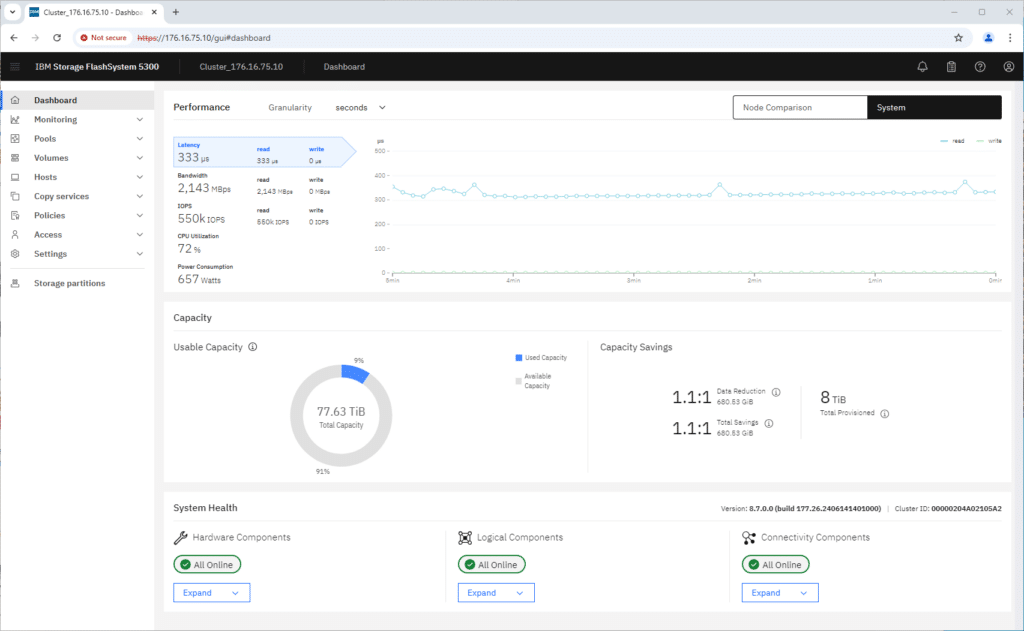
The 5300’s Web management UI has a thoughtful design and user-centric functionality. Upon first login, administrators are greeted with a sleek, minimal interface. The dashboard presents a clear, at-a-glance overview of the system’s health, capacity utilization, and performance metrics, allowing IT professionals to quickly assess the array’s status. Navigating the various sections is intuitive, with a logical menu structure, making management tasks straightforward.
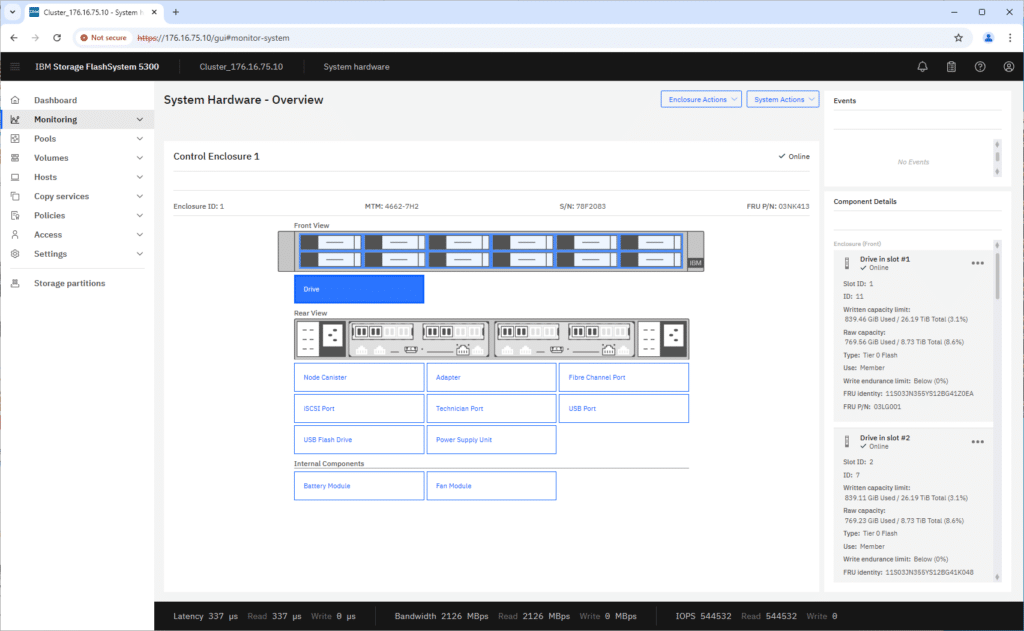
Thanks to well-designed wizards and form layouts, users can add hosts, configure storage pools, and manage volumes through streamlined processes that can be completed in just a few clicks. Performance monitoring is easy, with real-time graphs and charts displaying crucial metrics like IOPS, latency, and throughput. The interface’s responsiveness ensures that even complex operations like setting up replication feel swift and effortless. This combination of feature-rich functionality and ease of use significantly reduces the learning curve for new administrators while providing the depth and control that experienced professionals demand.
IBM Storage FlashSystem 5300 Performance
Test Setup:
IBM FlashSystem 5300
- 12 x 9.6TB SSDs
- 128GB Cache
Dell PowerEdge R760
- 2 x Intel Xeon 8592+ CPUs
- 24 x 64GB DDR5 RAM
- 4 x Dual-Port Emulex 32Gb FC HBA
- Windows Server 2022
When testing the IBM FlashSystem 5300, we leveraged a direct-connected approach with a single client-server. On the client, we installed four dual-port 32Gb Emulex HBAs and connected each port directly to the storage array for peak performance. The test layout for the storage used a DRAID6 (Distributed RAID6) scheme with a standard pool, which we then carved out eight 1TB volumes.
Sequential Performance: The 5300 demonstrates impressive sequential read performance, peaking at 25.2 GB/s for 128K blocks. Sequential write performance, while lower, remains competitive at 9.1 GB/s for 128K blocks.
| Workload Name | Bandwidth | Throughput (IOPs) | Avg. Latency (usec) |
| Sequential Read 8k | 10.3 GB/s | 1253k | 403.52 |
| Sequential Write 8k | 4.3 GB/s | 531k | 961.79 |
| Sequential Read 128k | 25.2 GB/s | 193k | 2657.67 |
| Sequential Write 128k | 9.1 GB/s | 69k | 7355.97 |
| Sequential Read 1M | 23.1 GB/s | 22k | 5814.76 |
| Sequential Write 1M | 7.6 GB/s | 7276 | 17583.99 |
Random Performance: In random access scenarios, the system’s in-cache performance is notably robust, reaching 547K IOPS for 4K random reads.
| Workload Name | Bandwidth | Throughput (IOPs) | Avg. Latency (usec) |
| Random Read 4k (Q32) | 2.5 GB/s | 632k | 1617.63 |
| Random Write 4k (Q32) | 556 MB/s | 136k | 3770.79 |
| Random Read 4k (Q16) | 1.8 GB/s | 459k | 554.85 |
| Random Write 4k (Q16) | 558 MB/s | 136k | 1878.07 |
| Random Read 4k (Q16) within Cache |
2.2 GB/s | 547k | 464.67 |
| Random Write 4k (Q16) within Cache |
1 GB/s | 267k | 956 |
| Random Read 8k | 4.8 GB/s | 598k | 854.33 |
| Random Write 8k | 1.1 GB/s | 135k | 3787.94 |
Mixed Workloads: For mixed read/write scenarios, performance scales well as the read percentage increases, with the 90/10 read/write mix for 8K blocks achieving 442K IOPS and 3.6 GB/s bandwidth.
| Workload Name | Bandwidth | Throughput (IOPs) | Avg. Latency (usec) |
| Random 4k (70/30 Mixed) |
1.3 GB/s | 339k | 3023.26 |
| Random 8k (70/30 Mixed) |
2.5 GB/s | 317k | 1612.11 |
| Random 4k (80/20 Mixed) |
1.6 GB/s | 396k | 2587.28 |
| Random 8k (80/20 Mixed) |
3 GB/s | 370k | 1379.77 |
| Random 4k (90/10 Mixed) |
1.9 GB/s | 478k | 2134.92 |
| Random 8k (90/10 Mixed) |
3.6 GB/s | 442k | 1155.32 |
Transparent Pricing
It is not exactly a feature, but one standout decision IBM has made is publicly listing pricing for the FlashSystem 5300, a relatively uncommon practice in the enterprise storage industry. Most vendors require customers to go through lengthy sales processes or negotiations to obtain pricing information, but IBM takes a more transparent approach with the 5300. By providing straightforward, upfront pricing, IBM helps organizations make more informed decisions about their storage investments without opaque pricing structures’ typical delays or uncertainties.
Conclusion
The IBM FlashSystem 5300 doesn’t just deliver on performance—it also brings enterprise-grade resiliency and scalability to the table. Moreover, with features like Safeguarded Copy and HyperSwap, the 5300 ensures data protection and business continuity, thus making it a strong fit for mission-critical workloads. Its scalability offers flexibility, allowing businesses to start small and grow as needed while maintaining high performance. Furthermore, the system’s hybrid cloud integration and straightforward GUI management make it easy to deploy, monitor, and scale, offering a well-rounded solution for organizations looking for a balance of power, security, and ease of use in their storage infrastructure.
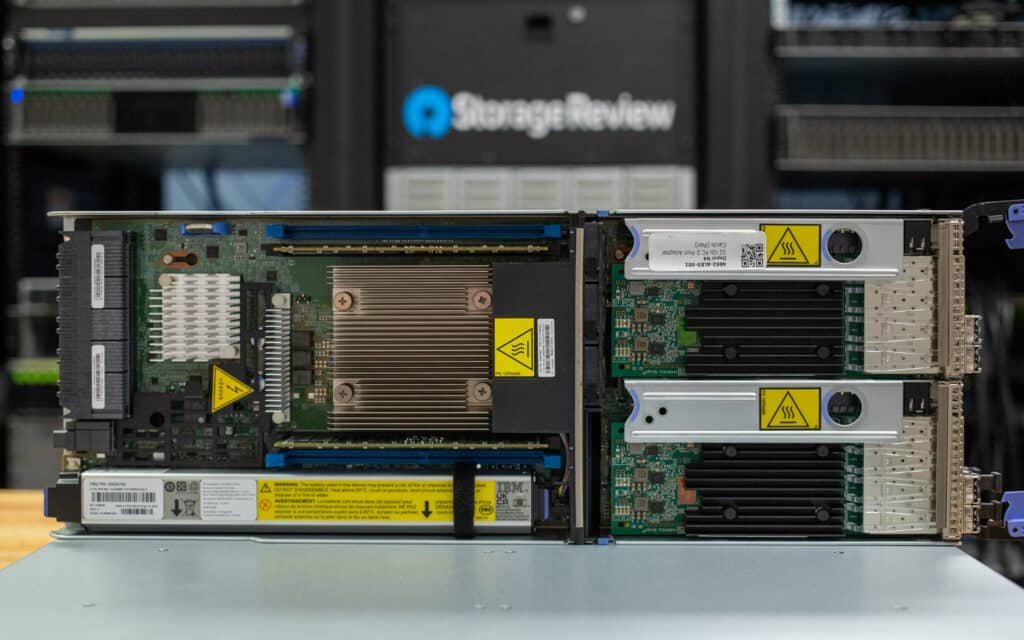
In addition, the FlashSystem 5300’s performance benchmarks further solidify its position as a robust entry-level enterprise storage solution. Specifically, with exceptional sequential read speeds reaching 25.2 GB/s for 128K blocks and strong random read performance of 632K IOPS for 4K blocks, the system proves it can efficiently handle diverse workloads. Furthermore, the 5300 can be configured with a bigger cache, consequently allowing a further boost in performance.
Notably, IBM’s decision to make pricing publicly available is refreshing, allowing businesses to easily compare options and assess their needs without lengthy sales processes. As a result, this transparency, combined with the system’s high performance, scalability, and advanced features, positions the FlashSystem 5300 as a strong contender for organizations seeking a powerful, efficient, and cost-effective storage solution. Finally, with its 64Gb Fibre Channel readiness and Quantum-Safe encryption, the FlashSystem 5300 is well-equipped to meet current and future demands, ultimately offering a future-proof investment for evolving IT infrastructures.
A special thanks to IBM Premier Business Partner MAPSYS! They coordinated delivering the IBM Storage review unit to our lab for a few weeks for this review. You can see MAPSYS’ IBM Storage published street pricing at flash.mapsys.org.





 Amazon
Amazon